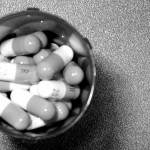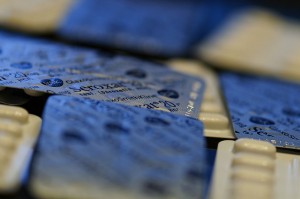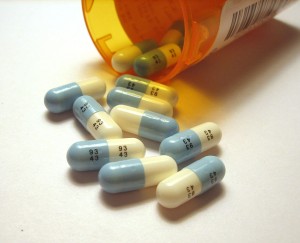
This important paper (Sharma et al, 2016) has rightly made the headlines. Dedicated work by a team of committed researchers overcame resistance from the European Medicines Agency and pharmaceutical companies. There are numerous concerns about the safety of antidepressants particularly in children and young people.
Methods
The authors had to fight hard to get what are called clinical study reports on drug trials of SSRI (specifically fluoxetine, paroxetine and sertraline) and SNRI antidepressant drugs (specifically duloxetine and venlafaxine in both normal release and extended release versions) lodged with the European Medicines Agency and the UK’s Medicines and Healthcare products Regulatory Agency. These clinical study reports summarised adverse events in the trials, either as lists of events or brief patient narratives. They were unable to get clinical study reports for all drugs or the more detailed case report forms for any of the drugs. Information was also obtained from Eli Lilly websites on trials of fluoxetine and duloxetine. Double blind randomised controlled trial information was included in the analysis.
Two people independently reviewed this information and resolved any disputes through consensus discussions. The primary outcomes were mortality and suicidality (suicide, self-harm acts or preparation or suicidal ideation). Secondary outcomes were aggressive behaviour and akathisia. Apart from suicide, summary outcomes such as suicidality or aggression inevitably involve grouping together quite disparate events.
Results were combined in several ways in the data tables; for each antidepressant, antidepressants combined and placebo. There was also data on whether adverse events occurred pre-randomisation (before being allocated the trial drug or placebo) or post-randomisation (when patients were on the trial drug or placebo).
Statistical analysis was performed with combined drugs v placebo then further split into adults and a separate analysis for children/adolescents combined.
“Many of the treatments included in this analysis are currently neither routinely used nor recommended in young people.”
– Dr Michael Bloomfield, Clinical Lecturer in Psychiatry, MRC Clinical Sciences Centre and UCL

Paroxetine (Seroxat/Paxil) is not recommended for use in children or young people.
Results
For me there are two important findings. The first was the significant under-reporting of adverse events. This was because they were often classified generously as not being due to the drug and so were omitted from final reports and analysis. As an example, 32 of 63 suicidal ideation events were coded as “emotional liability” or “worsening of depression”, but the narrative accounts made clear that these events were actually suicidal ideation. This highlights the continuing problem of getting accurate safety data out of trials run by pharmaceutical companies. We need to have stronger independent oversight of this safety data and a more open policy by pharmaceutical companies to sharing data. Of course it can be argued there are issues of interpretation, but it’s better to be open and discuss these issues in daylight.
The second important finding was that although antidepressants are relatively safe in adults, the risks are higher in children and young people, particularly for paroxetine.
I will further discuss these risks in terms of absolute percentage increase in antidepressants v placebo (% chance of adverse event in antidepressants – % chance of adverse event in placebo). This is then converted into Numbers Needed to Harm (NNH) by the simple formula 1/(absolute % increase risk of adverse events in antidepressant). I entered the figures for adverse events post-randomisation for the overall comparison. The overall comparison has combined all the antidepressants together. I repeated the analysis for children and young people but separated it into different drugs; this was because there seemed differential effects between antidepressants and also because smaller number of trials meant it was easier for me to do. The results have a greater degree of confidence for the combined (adult and child) results than for the child and adolescent results on their own, due to the larger numbers of people in the combined analysis.
All figures are rounded. As you may know, Excel doesn’t make mistakes, so any errors in calculation are down to me! Please let me know in the comments below if you spot anything that needs correcting. As a dutiful elf, I love to crowd-source my peer review!
Combined results for all trials
Suicide
- No difference between the two groups with a minuscule advantage for antidepressants (0.01%)
- Number Needed to Benefit (not Harm) of about 9,115. (This means that we would have to give 9,115 depressed people antidepressants to prevent 1 suicide, compared to placebo).
Suicidality
- Including suicides, acts, preparations and threats of self-harm and suicidal ideation with a 0.07% increase in suicidality events in people on antidepressants compared to placebo
- Number Needed to Harm of 1,432 (i.e. would have to give 1,432 depressed people antidepressants to have a suicidality event). (From now on I’ll use shorthand, so this would be NNH=1,432).
Aggressive acts
- Showed an absolute percentage increase in antidepressants of 0.18% and a Number NNH=535.
Akathisia
- (Such as inner restlessness) gave an absolute percentage increase of 0.11% and a Number NNH=880.
Results for children and young people
Now let us look at the results for children and young people with the same type of outcomes as before, but also broken down by drug.
Suicide
- No suicides as far as I can tell in children and young people
Suicidality
- Fluoxetine had an absolute percentage increase of 1.5% with NNH=63
- Paroxetine had the largest absolute percentage increase of 2.6% and NNH=38
- Sertraline’s absolute percentage increase was the lowest at 0.7% with NNH=142.
Aggressive acts
- Fluoxetine had a tiny reduction in aggression with absolute percentage reduction of 0.5% and NNB (Number Needed to Benefit)=190
- Paroxetine again had the highest absolute percentage increase of 3.6% with NNH=28
- Sertraline had an absolute percentage increase of 1.4% with NNH=71.
Akathisia
- Fluoxetine had the highest akathisia problems with an absolute percentage increase of 1.67% and NNH=60
- No figures for paroxetine
- Sertraline reduced the chances of akathisia slightly, with an absolute percentage reduction of 1.1% and a NNB=91.
Summary
So the results indicate a low risk of these types of outcomes in adults.
In children and young people:
- The risks were particularly high for paroxetine for suicidality and aggression
- Fluoxetine and to a lesser extent sertraline were also associated with increased suicidality
- Fluoxetine wasn’t associated with aggression
- Sertraline wasn’t associated with akathisia
- Paroxetine has a short half-life, which could explain why it’s strongly associated with these adverse effects, as well as with withdrawal syndromes in all age groups.

Fluoxetine and to a lesser extent sertraline were associated with increased suicidality (which includes acts of harm and suicidal thinking).
Strengths and limitations
- There were diligent and persistent efforts by researchers to get as much data as possible
- The study used two independent researchers to classify adverse events, with consensus meetings to resolve any issues
- This is a minor point, but they used a “fixed effects” model rather than a “random effects” model. Given the variability of different drugs causing different side effects, a random effects model may have been better, although this is unlikely to significantly alter the results
- There seems quite a bit of heterogeneity across studies, particularly in children and young people across the different drugs.

A random effects model may have been better than the fixed effects model used by the authors.
Discussion
In this blog I have looked at some of the risks associated with antidepressants but not all, for example: nausea, headaches, sedation, sexual dysfunction, withdrawal syndrome (these were not reported in this review but have been studied in detail elsewhere). In medicine it’s a case of weighing up the advantages of a specific medication against the risk of harm. Ideally we want a high chance of benefits, set against a low risk of harm. We also need to consider what is the likelihood and nature of harm, if we don’t treat someone, as well as the benefit/harm comparisons for alternative treatments (in the case of depression, psychotherapy for example).
A good source of information on the effectiveness of antidepressants is the British Association of Psychopharmacology (BAP) guidelines on the subject, recently revised (Cleare et al 2015). They measure benefit using the NNT (Number Needed to Treat, similar to NNB above), which relies on defining outcomes in a “categorical” way; either improved or not. The outcome used by the BAP for improvement is a 50% reduction in HDRS/MADRS scores (that’s a rating scale for the severity of depression) or marked improvement or better on Clinical Global Impression scale (a clinical judgement by the rater). Of course this is a bit blunt (someone with 49% reduction in rating scale score would count as a failure but 51% as a treatment success) but a line has to be drawn somewhere to define success and failure.
The BAP Guidelines suggest in adults NNT for improvement is 7 for antidepressants compared to placebo (e.g. (47% response rates in antidepressants vs. 32% for placebo).
For children and adolescents, a recent Cochrane meta-analysis (Hendrick et al (2012)) suggests a lower effectiveness of antidepressants in children and adolescents (45% response rate in antidepressants v 38% in placebo) with NNT=14 (i.e. double the figure in adults). Even an NNT of 14 isn’t bad for a medication, but clearly it needs to be compared with the risks of treatment.
Another way of measuring response is to look at the overall reduction of depressive symptoms using a combined effect size in a meta-analysis. Effect size of 0.2 is said to be “small”, 0.5 is “medium” and 0.8 is “large”. Including data from “missing” trial data, the BAP guidelines indicate an effect size of 0.31 advantage for antidepressants compared to 0.4 if only published trial data is used (both are still small effect sizes). Effect size is similar for children and adolescents, but seems more effective in adolescents (and some combined studies show no significant advantage in children).
It’s important when looking at effect sizes to remember they are an AVERAGE over many people. So a small effect size doesn’t usually mean a uniform small effect for everyone taking a medication. The small effect size may mean some people get a large advantage, another proportion have a small advantage and the rest have no effect or even get slightly worse. So antidepressants might make a big difference for a proportion of people, but this effect is “averaged out” to a small effect by the rest of the people on antidepressants having little benefit. When people complain of negligible clinical benefits for antidepressants, they seem to have forgotten that they are referring to averaged effects and that some people may have a large benefit. Some people prefer the NNT for all its flaws, just because these averages are sometimes a bit tricky to interpret.
The risks of suicidal thinking and acts of harm and aggression should be discussed with young people so that they and their parents can make an informed decision, but the findings should be viewed with extreme caution.
– Dr Paul Ramchandani, Consultant Child and Adolescent Psychiatrist with CNWL Foundation NHS Trust and Reader in Child and Adolescent Psychiatry, Imperial College London

Does this new paper add anything to our knowledge?
Summary
Looking at the overall picture, antidepressants have a definite but small advantage, on average, on symptoms (and this average effect may mean some people have a large benefit, but others a much smaller benefit) and a reasonably good impact to help people’s chances of improving. This benefit is more marked in adults than children or adolescents. Adolescents may respond better than children.
The risks of dangerous adverse effects are very low in adults but are much higher in children and adolescents. Balancing the chances of benefit versus the risks of harm gives us different conclusions in children, adolescents and adults.
- This suggests that antidepressant treatment represents a reasonable choice in adult depression
- In children (people under 12 years old) antidepressants should only be used with great caution and only after treatments such as psychotherapy have been tried
- For adolescents (people under 18 years old), antidepressants can be tried as second line treatment after an alternative evidence-based treatment such as psychotherapy (usually CBT) has been tried
- Paroxetine should not be prescribed to people under 18 years old
- In children and adolescents, prescribing of antidepressants should only be initiated by secondary care (i.e. psychiatrists). Clear warnings must be given about dangerous adverse effects and close monitoring for these adverse effects must be undertaken by mental health services.
Paroxetine has been contra-indicated in children and young since mid-2003. In practice, this means that it should not to be used without very good reason by a specialist. NICE recommends fluoxetine in depression only after specific psychotherapy has been tried. For children, NICE notes little evidence of antidepressant effectiveness. For adolescents, NICE states sertraline or citalopram can be used if fluoxetine has not been successful.
Unfortunately, this advice particularly about children and adolescents depends on the local health environment. Child and adolescent mental health services and voluntary services may be overstretched, meaning patients and GPs may have limited access to treatments with fewer adverse effects. Health systems in other countries may also limit access to these other treatments or favour people seeing psychiatrists initially.
Finally, it is vital there is improved reporting of adverse outcomes in drug trials by researchers and this may require independent oversight and scrutiny. Data on these trials should be easily available for scrutiny. This also applies to other branches of medicine, not just psychiatry.

A lack of funding may mean that children and young people have limited access to treatments with fewer adverse effects.
If you need help
If you need help and support now and you live in the UK or the Republic of Ireland, please call the Samaritans on 116 123.
If you live elsewhere, we recommend finding a local Crisis Centre on the IASP website.
We also highly recommend that you visit the Connecting with People: Staying Safe resource.
Links
Primary paper
Sharma T, Guski LS, Freund N, Gøtzsche PC. (2016) Suicidality and aggression during antidepressant treatment: systematic review and meta-analyses based on clinical study reports. BMJ 2016;352:i65
Other references
Cleare et al (2015) Evidence-based guidelines for treating depressive disorders with antidepressants: A revision of the 2008 British Association for Psychopharmacology guidelines. Journal of Psychopharmacology 2015, Vol. 29(5) 459–525 DOI: 10.1177/0269881115581093
Hetrick SE, McKenzie JE, Cox GR, Simmons MB, Merry SN. Newer generation antidepressants for depressive disorders in children and adolescents. Cochrane Database of Systematic Reviews 2012, Issue 11. Art. No.: CD004851. DOI: 10.1002/14651858.CD004851.pub3.
Moncrieff J. (2016) Misrepresenting harms in antidepressant trials (Editorial). BMJ 2016;352:i217 doi: 10.1136/bmj.i217


Antidepressants: benefits and harms in children and adults https://t.co/AZQoao2ndr #MentalHealth https://t.co/uwVp0rAsjZ
My blog on weighing up risks and benefits of antidepressants & how it varies by age https://t.co/aYQsDhz1An
Today @SameiHuda on a systematic review of the adverse effects of antidepressant treatment in children & adults https://t.co/q6ZvjW5KSx
@Mental_Elf great piece @SameiHuda with important recommendations, drug-drug interactions imp. given prevelance of substance use at this age
@ian_hamilton_ @Mental_Elf thanks Ian! Great point re interactions – make a comment about that on blog?
@SameiHuda @Mental_Elf thanks, just have !
Weighing up the risks and benefits of antidepressants -https://t.co/04jbTDCLYn @PsychiatrySHO @mark_bolstridge @1boringoldman
Although broadly drug use is declining among young people there are still a substantial number who use drugs such as cannabis, alcohol etc. We don’t have enough information about how these substances interact with prescribed medication such as anti-depressants. It is likely that young people who experience problems with their feelings including mood are more likely to use substances and be prescribed anti-depressants increasing the risk of drug-drug interactions.
A better understanding of these interactions is needed including if the effects are desired/undesired & harmful/benign….
RT @Mental_Elf: Antidepressants for depressed children: we consider the risks of suicidal thinking & acts of harm and aggression https://t.…
.@Mental_Elf @SameiHuda using fixed rather than random effects will bring false degree of precision to results https://t.co/BAcZ3UKm6P
@in_psych @Mental_Elf was I right that a random effects model was better choice ? Different drugs, different populations etc?
@SameiHuda @Mental_Elf most likely – can’t access paper right now to check
.@Mental_Elf @SameiHuda 95%CI for NNH likely to be very wide https://t.co/BAcZ3UKm6P
RT @in_psych: Great @Mental_Elf blog on suicidality etc with antidepressants by @SameiHuda https://t.co/BAcZ3UKm6P
Excellent post by @SameiHuda on the recent review about benefits and costs of antidepressants https://t.co/fI5cfLYNCy H/THE @Mental_Elf
@PsychologyBrief @Mental_Elf thanks ??
Hi @tshealthpolicy Our blog of your ‘Suicidality & aggression during antidepressant treatment’ SR https://t.co/q6ZvjW5KSx by @SameiHuda
.@TShealthpolicy Do please have a read and let us know what you think. Cheers, André @SameiHuda
@Mental_Elf @SameiHuda 1/2 Thanks – but note the NICE guidance is good but those restrictions don’t apply in Denmark or other countries
@Mental_Elf @SameiHuda 2/2 so we looked at more drugs. Separating our data by drug will give erroneous results – the quality of data varied
@TShealthpolicy @Mental_Elf the drugs seemed to have quite different rates of producing side effects in C/YP: fits with clinical experience1
@SameiHuda @Mental_Elf if clinical exp shows diff risks of AEs & we if we had good data and all trials for all drugs – it may have shown it
@SameiHuda @Mental_Elf But we had some drugs with individual patient data, some with summary reports. Not equal to compare & divide up data
@TShealthpolicy @Mental_Elf hi how did the research team feel about headlines saying ADs? suicide risk when this wasn’t what your paper said
@TShealthpolicy @Mental_Elf so although quality of data varied, it seems that avoiding paroxetine in C/YP would help reduce risks of harm 2
@TShealthpolicy @Mental_Elf the point of local health contexts is a good one Even in UK lack of CAMHS access may mean ADs used 1st in C/YP 3
Join the debate!
Antidepressants
Children & adolescents
Aggression or Harm
What’s the link?
https://t.co/q6ZvjW5KSx https://t.co/BLYoVJhUlD
Great article about possible harms of antidepressants, highlights importance of access to psychological treatments: https://t.co/yhGwZBISDm
@DrG_NHS my blog on Mental Elf on recent paper assessing harms of antidepressants https://t.co/04jbTDCLYn but also weighing up benefits
#Antidepressants: benefits & harms in children & adults: https://t.co/VY2Qa8BahY Review of drug trial #evidence finds risks in #children
@thus_spake_z important to ensure good access to CAMHS or may lead to overuse of antidepressants https://t.co/04jbTDlazN
Are antidepressants safe and effective? @SameiHuda reviews evidence https://t.co/Cf0mGObjEK
@DrSRanote @louiseholly1 @MMockett can lack of access to CAMHS lead to using antidepressants inappropriately? https://t.co/aYQsDhz1An
@CEP_UK a blog on recent BMJ paper on risks of antidepressants and weighing up benefits https://t.co/04jbTDCLYn evidence-based psychiatry !
@tadhg50 I wrote this blog about 10 days ago it’s out today https://t.co/04jbTDCLYn on antidepressant risks and benefits
@david_colquhoun blog on recent paper weighing up evidence of risks v benefits in antidepressants https://t.co/04jbTDCLYn
@louiseholly1 @MMockett blog link is https://t.co/04jbTDCLYn
@AllenFrancesMD my latest Mental Elf blog on recent BMJ paper on risks of antidepressants & how they vary by age https://t.co/04jbTDCLYn
Candour in releasing findings without prejudice by interested parties would benefit all.
All young people with significant depressive symptoms should be referred to CAMHs, triage is based on presentation and risk . Most will access CBT but some too ill and/or unable to engage in CBT, some need antidepressants, post puberty depression more like adult depression, pre-pubertal more likely to be different and in response to psychosocial issues therefore need different approach. Suicidal ideation risk with anti-depressants should be discussed before use and monitored during treatment.
Antidepressants: benefits and harms in children and adults https://t.co/QqWwwBh28j via sharethisi
RT @Mental_Elf: Don’t miss – Antidepressants: benefits and harms in children and adults https://t.co/q6ZvjW5KSx
RT @vaughanbell: Excellent @SameiHuda analysis of the recent antidepressant and suicidality study https://t.co/MI4GAfSXAo Crystal clear acc…
Misleading comment. Suicide rate lower in antidepressants but higher risk of DSH in C/YP https://t.co/aYQsDhz1An https://t.co/6BOwErXD9J
Antidepressants: benefits and harms in children and adults https://t.co/gj7Vd5A1MR
Interesting article antidepressants in YP should not be the first treatment choice https://t.co/3nKdv4TQ4l
Antidepressants have their place. They should only be prescribed via a specialist. Fluoxetine is the preferred and licensed choice. Talking therapies are available and should be tried. Future in Mind will further help this to be developed. Unfortunately some young people really struggle with talking therapies especially those with co morbidities such as ASD and significant Conduct Disorders. This is where anti depressants can be invaluable.
@SameiHuda @TShealthpolicy In this case blog comments would be best please Tarang https://t.co/q6ZvjW5KSx
@Mental_Elf @SameiHuda Ok will post comment – so it remains linked to your piece.
@WesselyS my blog on latest BMJ paper on risks of antidepressants & weighing them up with benefits https://t.co/04jbTDCLYn
@BAPsych my Mental Elf blog on recent BMJ paper on risks of antidepressants and benefits from BAP guidelines https://t.co/04jbTDCLYn
Super important information for anyone considering antidepressant medication for their child or teenager. “In… https://t.co/6GF1jcWOUz
@SameiHuda on the risks of antidepressants for @Mental_Elf https://t.co/1UTp1uZe83
@SimonSRN @Mental_Elf thanks ??
Firstly thanks so much to The Mental Elf and Samei Huda for covering our research. We are very happy that this is encouraging debate and bringing forth different opinions on the subject.
Firstly I want to clarify my background and that I really don’t have any vested interests. I’m a methodologist and so very much interested in the comments and feedback I have received so far from both patients and professionals.
Wow – limited space in comments so will keep this brief. I have done HTAs for NICE from Uni of Sheffield and national clinical guidelines for NICE when I was employed there directly. Now it has been a decade working across different clinical areas which includes working for Novo Nordisk, a Danish pharmaceutical company, on evidenced based decision making. I think the NICE guidance is really good but those restrictions don’t apply in Denmark and other countries so important to highlight these issues. NICE conceded that only fluoxetine had greater benefit than harm for this age group, for other drugs it was the other way round.
Data from our study was separated by drug and crude individual risk rates were presented for the different drugs in the above article. This is misleading, as you are comparing oranges and apples. We had only 3 trials for fluoxetine for example and as they were older trials, their quality was very poor. While we had more trials for the other drugs and for the newer drugs very good quality data, with individual patient data. It simply could be that we detected more harms in these newer drug trials because they had more detailed information. For example the fluoxetine trials had a solicited adverse events checklist that the clinical investigator asked the patient at every visit. Only if a patient mentioned something over and beyond that checklist it was also noted in a non-solicited adverse events table. All the serious harms we noted were from this additional table but not all centres or clinical investigators developed this additional list. We also did not have any individual patient data for these fluoxetine trials and from our study we found where we had this additional information, many harms were buried in there.
Additionally, using crude risk rates is statistically poorer than looking a meta-analysis result as that takes into account the different trial sizes and weights their values accordingly. This is especially important for rare events data where only certain methods of even meta-analyses are accurate (such as the one we used – Peto’s odds ratio). This is because that method is able to adjust for null events and the low rate of events. This is also applicable to the comment made on twitter regarding individual suicide rates. It is unfortunate that some media outlets shortened suicidality risk to suicide risk, probably so it is more accessible to the general public. That said these were short trials for the most part and increase in suicidality risk after say 6-8 weeks on treatment should be enough of a concern as in clinical practice people are on these drugs for longer periods and an increased suicidal behaviour risk at 6 or 8 weeks is very highly correlated with an increased suicide risk in longer periods. But mathematically once again splitting the meta-analysis result to give individual crude risk rates when we are talking about only 2 versus 2 suicide events is not ideal and we should be very cautious of any interpretations. As Gunnell et al from MHRA noted in his work on this topic back in 2004, you can only conclude that there risk ranges from either a possible protection to a 3 fold increase – i.e we do not know the true answer. Any conclusions about this from our study should be the same – possible protection to possible harm.
Hi thanks for comment
The risk of completed suicide from “suicidality” is very low. The risk of increased “suicidality” seems to happen in my experience in the early period after drug started or dose increased covered by the studies rather in long term treatment. Also withdrawal may increase risk of suicidality
So all in all given low absolute increased risks of “suicidality” in antideps in adults and lower actual OBSERVED rate of suicide in antideps v placebo it is highly unlikely that the antideps will increase suicide in adults. A hypothesised risk from a tiny absolute increased risk of “suicidality” during period of max observed risk (excluding worhdrawal) leading to a small risk of competed suicide does not outweigh OBSERVED lower rate of suicide
I did think the study was very good though
Re my comment above applies to adults. For C/YP the risks are clearly higher but I defer to my CAMHS colleagues as to how that weighs up in clinical practice
Thanks for that – I can always explain the numbers and the data but also good to hear your professional perspectives drawn from years of experience in the field speaking with patients.
Antidepressants: benefits and harms in children and adults https://t.co/tPXlIQzeTz via @sharethis
Antidepressants: benefits and harms in children and adults https://t.co/58FPCJhnQY via sharethis
Antidepressants: benefits and harms in children and adults – https://t.co/2TAhMPVv8F. Excellent from @sameihuda.
@larkinf have u seen blog I did for mental elf on the paper plus comments from lead author ? https://t.co/aYQsDhz1An
Indeed @PsychiatrySHO
Our blog on this study by @SameiHuda https://t.co/q6ZvjVO9tX
@SMC_London coverage https://t.co/6ApR1QLDPr
@SameiHuda @PsychiatrySHO @AlysColeKing @DrS_Reynolds @paulramchandani Here’s link for all https://t.co/q6ZvjVO9tX Do post a comment
[…] http://www.nationalelfservice.net/treatment/antidepressants/antidepressants-benefits-and-harms-in-ch… […]
[…] There continues to be considerable debate about the value of antidepressants in the treatment of depression. Previous Mental Elf blogs have explored the use of antidepressants and a there’s a particularly good post by Samei Huda here on the benefits and harms of antidepressants. […]
[…] (Näslund et al, 2017; see also: Dutta & McLaughlin, 2018) in adults, and in children (NNT=14 (Huda, 2016), Hetrick […]